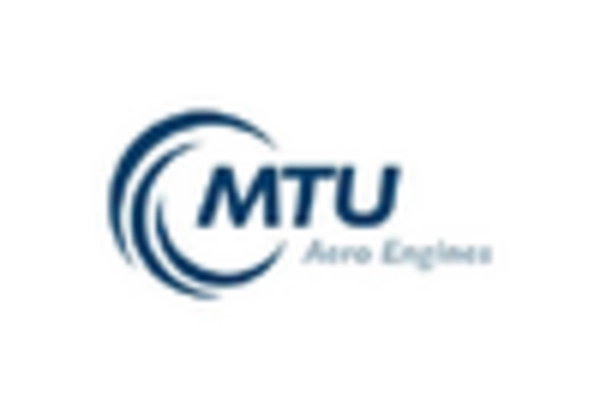Increasing Air Traffic Demand
The aircraft engine-mro market is experiencing a notable surge in demand due to the increasing air traffic in the United States. As more airlines expand their fleets to accommodate rising passenger numbers, the need for maintenance, repair, and overhaul services becomes critical. According to the Federal Aviation Administration (FAA), air traffic is projected to grow by approximately 3.5% annually over the next decade. This growth directly correlates with the demand for efficient and reliable aircraft engine maintenance services, as airlines seek to minimize downtime and ensure safety. Consequently, the aircraft engine-mro market is likely to benefit from this upward trend, as operators prioritize engine reliability and performance to meet the expectations of a growing customer base.
Expansion of Fleet Modernization Programs
The aircraft engine-mro market is poised for growth due to the expansion of fleet modernization programs among airlines in the United States. Many operators are investing in upgrading their existing fleets with newer, more efficient engines that require specialized MRO services. The FAA estimates that the average age of commercial aircraft in the U.S. is around 11 years, prompting airlines to consider modernization to improve operational efficiency and reduce maintenance costs. This trend not only drives demand for MRO services but also encourages collaboration between engine manufacturers and MRO providers to develop tailored maintenance solutions. As modernization efforts continue, the aircraft engine-mro market is likely to see increased activity and investment.
Regulatory Compliance and Safety Standards
The aircraft engine-mro market is significantly influenced by stringent regulatory compliance and safety standards imposed by aviation authorities in the United States. The FAA mandates rigorous maintenance protocols to ensure the safety and airworthiness of aircraft engines. As regulations evolve, MRO providers must adapt their services to meet these requirements, which often leads to increased demand for specialized maintenance solutions. The cost of non-compliance can be substantial, prompting airlines to invest in reliable MRO services. This regulatory landscape creates a stable environment for the aircraft engine-mro market, as adherence to safety standards is paramount for operators aiming to maintain their operational licenses and avoid penalties.
Technological Integration in MRO Processes
The integration of advanced technologies in maintenance, repair, and overhaul processes is reshaping the aircraft engine-mro market. Innovations such as predictive maintenance, artificial intelligence, and data analytics are enhancing operational efficiency and reducing costs. For instance, predictive maintenance can decrease unscheduled engine repairs by up to 30%, allowing airlines to optimize their maintenance schedules. As these technologies become more prevalent, MRO providers are likely to invest in upgrading their capabilities to remain competitive. This technological shift not only improves service delivery but also aligns with the industry's push for greater efficiency and reliability, thereby driving growth in the aircraft engine-mro market.
Growing Focus on Engine Performance Optimization
The aircraft engine-mro market is increasingly driven by a growing focus on engine performance optimization. Airlines are under constant pressure to enhance fuel efficiency and reduce operational costs, leading to a heightened demand for MRO services that can improve engine performance. According to industry reports, engines that undergo regular maintenance can achieve fuel savings of up to 5%, which is a significant incentive for operators. As airlines strive to meet environmental regulations and reduce their carbon footprint, the demand for specialized MRO services that enhance engine efficiency is likely to rise. This trend presents a substantial opportunity for growth within the aircraft engine-mro market.

















Leave a Comment